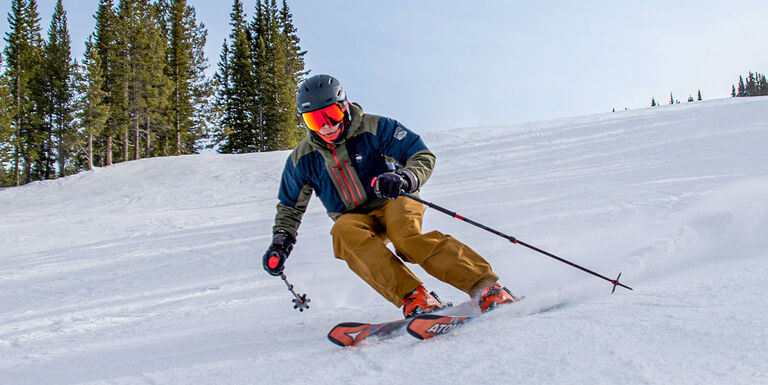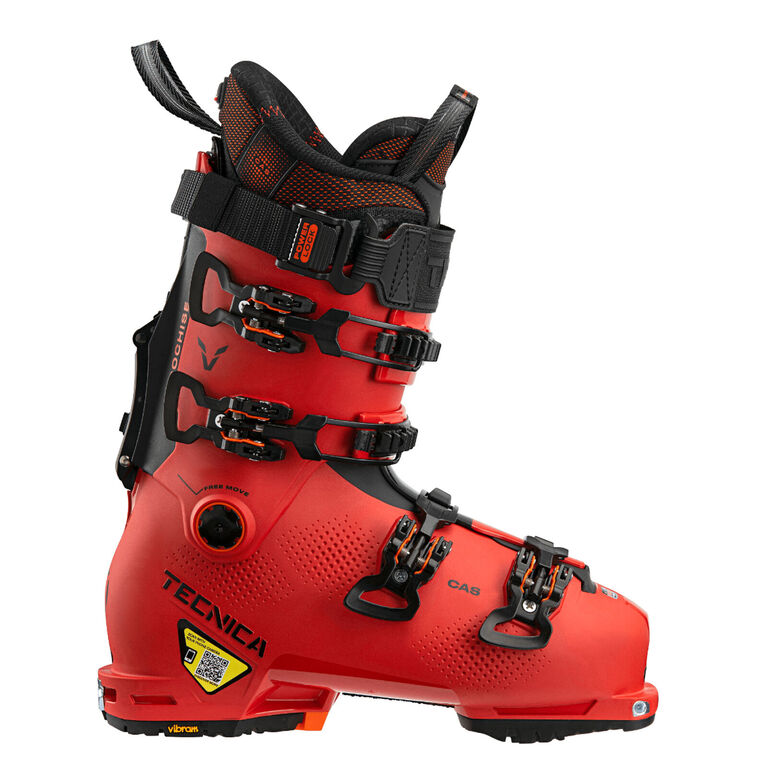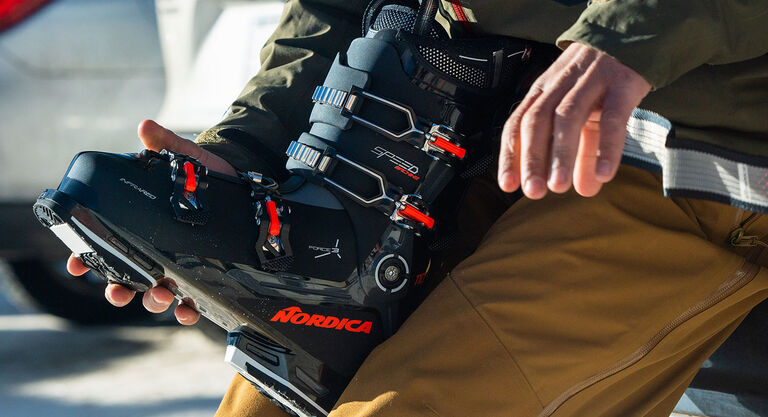Ask The Expert
Kumar K.
Expert boot fitter Kumar shares exclusive insights on some of his top boot fitting tips, guidelines, and misconceptions when looking for ski boots.

EXPERT IN
BOOT FITTING
TIME SPENT ON THE MOUNTAIN
6 YEARS
HOMETOWN
MINNEAPOLIS, MN
WHAT ARE THE TOP REASONS WHY SOMEONE SHOULD PURCHASE THEIR OWN BOOTS?
Your own boots will be a significantly better fit than rental boots, which leads to more comfort and improved skiing performance.
WHAT ARE A FEW COMMON MISCONCEPTIONS ABOUT SKI OR SNOWBOARD BOOTS? WHAT IS THE TRUTH BEHIND THESE?
Misconception: Ski boots are always uncomfortable.
Truth: Many people will not be able to find a truly "comfortable" or pain-free feeling boot in a rental boot or an out-of-the box retail boot. But with the help of a skilled boot fitter, almost anyone can have a pain-free, comfortable all-day skiing experience. Custom boot fitting isn't just for expert skiers or people with serious foot problems; it is for anyone and everyone.
Misconception: Ski boots should have room in the toes to be comfortable.
Truth: Many of the common complaints customers have about their boots actually stem from too much room/too big of a boot. A ski boot fits properly when the toes are more or less flush with the end of the boot. Too much room allows the foot to slide around in the boot and can cause more toe pain from the foot impacting the end of the boot with more energy.
AT WHAT POINT IN SOMONE’S SKI/SNOWBOARD JOURNEY WOULD YOU RECCOMEND PURCHASING YOUR OWN BOOTS?
Purchasing boots is the first step someone should take once they know that they want to continue pursuing skiing and want to progress their skills or increase their comfort and enjoyment. This might be after their first day or their first five seasons! The important thing to know is that good boots make the biggest difference of any piece of equipment to being comfortable, having fun, and becoming a better skier.
WHAT CAN SOMEONE EXPECT IN A CHRISTY SPORTS BOOT FITTING SESSION?
You can expect to spend about an hour with a bootfitter and walk away feeling confident and excited about your boots and ready to enjoy your next day skiing. You will try on multiple boots to compare and contrast, making sure you get the best fit possible. Your bootfitter will ask questions about your skiing style, ability level, and aspirations as a skier to help find a boot with the ideal performance level and price. You should also be prepared to share any past experiences with ski boots and pain points/discomfort you have experienced so that the bootfitter can be sure to address those issues.
WHAT BOOTS DO YOU HAVE AND WHY DO YOU LOVE THEM?
I love my Tecnica Cochise 130 boots. They have all the skiing performance of a high-end downhill boot and have a really precise fit that I feel improves my skiing. Having the walk mode and touring capability with these boots gives me the flexibility to use them for any type of skiing, from inbounds skiing to hike-to-terrain to backcountry touring. It also makes them comfier for getting from the car to the lift or hanging out at après!

WHAT BOOTS DO YOU HAVE AND WHY DO YOU LOVE THEM?
I love my Tecnica Cochise 130 boots. They have all the skiing performance of a high-end downhill boot and have a really precise fit that I feel improves my skiing. Having the walk mode and touring capability with these boots gives me the flexibility to use them for any type of skiing, from inbounds skiing to hike-to-terrain to backcountry touring. It also makes them comfier for getting from the car to the lift or hanging out at après!

WHAT ARE THE 3 MOST COMMON QUESTIONS YOU GET DURING BOOT FITTING SESSIONS?
1. HOW SHOULD MY BOOTS FIT?
Ski boots should fit very snug, but not uncomfortably so. When standing in a relaxed position in new ski boots, your toes should all be clearly touching the end of the boot without room to spare. When flexing the boot (leaning and putting pressure into the cuff of the boot, in an active skiing position), your toes should just slightly pull back from the end of the boot as the flexing motion causes the heel to move all the way back into the heel pocket. The entire boot should have a consistently snug feel throughout, without major pressure points or loose/baggy areas. The heel should feel seated in the boot and not lift when the boot is flexed. If the lower buckles of the boot need to be closed very tightly to get a snug fit, the boot is likely too high-volume and not an ideal fit.
2. WHAT FLEX BOOTS SHOULD I BE IN?
Flex is a matter of personal preference, but in general more advanced/aggressive and/or heavier skiers should be in a stiffer boot, whereas beginner/intermediate and/or lighter skiers should be in a softer boot. Advanced male skiers will often choose a boot with a flex rating of 120 or 130, and advanced female skiers generally ski in boots with a flex rating of 100-120. Beginner/intermediate male skiers will generally ski in a boot with a flex rating of 85-110, while beginner/intermediate female skiers will generally ski in boots with a flex rating between 65-90.
Keep in mind that there are exceptions to all these generalizations. For example, dedicated freestyle/park skiers often prefer a softer flexing boot, even if they ski at an expert/professional level. Since these types of skiers often hit big jumps and features, they prefer the suspension and rebound of a slightly softer boot instead of the support of a very stiff boot. It’s also important to know that there is no standardization of boot flex ratings across manufacturers—for example, the stiffness of a 120-flex Lange boot might feel quite different from the stiffness of a 120-flex Tecnica. The best way to figure out what boot/flex works for you is to go to a store to try on multiple models and get advice from a boot fitter.
3. WHAT DOES A FOOTBED DO?
A footbed has several important roles in improving the fit, comfort, and performance of a boot. The main purpose is to stabilize the foot inside of the boot. A common complaint many skiers have is that the medial side/under arch area of the foot can be painful or achy when skiing. This is often caused by pronation, or the rotation of the foot towards the inside of the boot, causing the medial side of the foot to press against the wall of the boot. A custom footbed with proper arch support helps prevent pronation and can relieve this pain. The footbed also helps to keep the foot seated in the proper position in the boot, with the heel sitting all the way into the heel pocket in the rear of the boot. This can help prevent unwanted sliding or movement of the foot within the boot, which can cause pain to the toes and other areas. It also helps improve performance by limiting unnecessary foot movement and increasing direct power transfer to the skis. Lastly, the custom footbed is a necessary step in progressing towards other custom boot modifications. Before a boot fitter modifies the shell of the boot, it is important to have a custom footbed in place to know that the skier’s foot is properly stabilized and seated in the boot, and makes pinpointing areas to punch, grind, or otherwise modify more accurate and effective.
HOW CAN YOU TELL IF A BOOT IS A GOOD FIT?
A good fitting boot should fit snugly all around the foot and ankle with no notable hot spots/pressure points or baggy areas. The toes should clearly touch the end of the boot when standing straight legged and pull back slightly from the end when the boot is flexed.

WHEN DO YOU RECOMEND A CUSTOMER GETS CUSTOM INSOLES?
Insoles help stabilize the foot in the boot both from front to back and side to side. They improve the fit and comfort of the boot by helping the foot to stay in the same, optimal position inside the boot at all times (heel seated all the way in the back of the heel pocket). They help prevent arch/navicular pain by limiting the foot's ability to pronate into the inside wall of the boot. I recommend insoles to almost all customers (and try to accurately describe the benefits and show that they aren't simply an upsell item) with the understanding that many won't choose to get insoles due to the additional cost. I'll recommend them especially for customers who describe experiencing discomfort in their boots that I suspect would be solved by an insole or for any skier who wants to improve the fit and performance of their boots. I also tell customers who might be on the fence about an insole that most any insole (including trim to fit boxed insoles) will help improve their fit over the stock insoles.
WHAT SOCKS DO YOU RECOMMEND FOR THE BEST COMFORT AND FIT?
Light or ultralight weight merino wool or wool blend ski socks. Thinner socks improve the fit of the boot and improve circulation while reducing sweat. The liner of the boot itself is what provides most of the warmth.
CAN YOU GIVE US 3 BOOT RECOMMENDATIONS FOR THE FIRST TIME BUYER?
1. Salomon S/Pro (many different models/flex ratings for men and women)—these boots have a great out of the box fit and a medium-volume shape that works for a wide range of skiers.
2. Nordica SpeedMachine (many different models/flex ratings for men and women)—mid volume fit with a well-crafted, precise feel that fits many different skiers.
3. Rossignol AllTrack (many different models/flex ratings for men and women)—These boots fit well for skiers with a higher/arch instep and a mid-width foot. The walk mode allows for more comfort and for the option to use for backcountry skiing with tech inserts in higher-price/higher-flex models.
Remember that just because these three boot models work for many people does not mean they will for everyone! To be sure of a good fit I highly recommend an in-person bootfitting session.
IF YOUR FRIENDS HAD TO GUESS WHERE TO FIND YOU ON THE MOUNTAIN, WHERE WOULD THEY LOOK?
Skiing bumps, in the trees, or most importantly wherever the snow is best!
DO YOU HAVE AN UNPOPULAR OPINION ABOUT SKIING?
Before I started skiing frequently, I was really into other outdoor sports and wanted to ski more but felt that skiing was quite exclusive due to the skill and expensive gear necessary; this really discouraged me from trying the sport. Now that I ski all the time and love it so much, I really wish there were more avenues to decrease the barrier of entry to skiing and get more people on the slopes!
IF YOU HAD TO EQUATE YOUR SKIING STYLE TO AN ANIMAL, WHAT WOULD IT BE?
I have an Australian Shepard at home who is extremely energetic and playful, so I would equate my skiing style to an Aussie! I’m always super psyched to ski wherever, with whoever, in pretty much any conditions, and will always have a good time.


